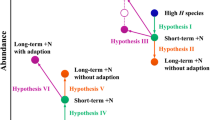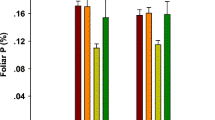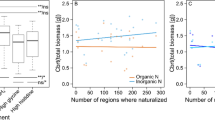Abstract
Background and aims
Niche complementarity arising from divergence in resource use is an important mechanism underlying species coexistence. We hypothesized fertilization with different N forms would generate plastic divergence among species with regard to their N form uptake and preference.
Methods
In the eighth year of a long-term N fertilization experiment in an alpine meadow on the Tibetan plateau, we labeled 11 common plant species with ammonium-15N or nitate-15N in subplots without fertilization (control) or fertilized with 7.5 g N m−2 yr−1 in the form of ammonium, nitrate, or ammonium nitrate to trace N form uptake.
Results
Depending on species, fertilization with nitrate or ammonium nitrate had positive, negative or neutral effects on NO3-N uptake rate, although ammonium fertilization showed little impact. By contrast, fertilization with any N form had little impact on NH4-N uptake rate. Consequently, effects of nitrate fertilization and ammonium nitrate fertilization on relative N form preference diverged among the species and the functional groups (grasses, sedges, legumes and forbs).
Conclusions
Alpine plant species can diverge in N form uptake and preference in response to long-term N fertilization, and such divergence may contribute to species coexistence after long-term fertilization.



Similar content being viewed by others
References
Ashton IW, Miller AE, Bowman WD, Suding KN (2008) Nitrogen preferences and plant–soil feedbacks influenced by neighbors in the alpine tundra. Oecologia 156:625–636
Ashton IW, Miller AE, Bowman WD, Suding KN (2010) Niche complementarity due to plasticity in resource use: plant partitioning of chemical N forms. Ecology 91:3252–3260
Boxman AW, Roelofs JGM (1988) Some effects of nitrate versus ammonium nutrition on the nutrient fluxes in Pinus sylvestris seedlings: effects of mycorrhizal infection. Can J Bot 66:1091–1097
Chase JM, Leibold MA (2003) Ecological niches: linking classical and contemporary approaches. University of Chicago Press, Chicago
Chesson P (2000) Mechanisms of maintenance of species diversity. Annu Rev Ecol Syst 31:343–366
Diekmann M, Lawesson J (1999) Shifts in ecological behaviour of herbaceous forest species along a transect from northern central to North Europe. Folia Geobot 34:127–141
Fowler D, Flechard C, Skiba U, Coyle M, Cape JN (1998) The atmospheric budget of oxidized nitrogen and its role in ozone formation and deposition. New Phyt 139:11–23
Galloway JN, Townsend AR, Erisman JW (2008) Transformation of the nitrogen cycle: Recent trends, questions, and potential solutions. Science 320:889–892
Houle D, Moore JD, Ouimet R, Marty C (2014) Tree species partition N uptake by soil depth in boreal forests. Ecol 95(5):1127–1133
Hutchinson GE (1959) Homage to Santa Rosalia, or why are there so many kinds of animals? Am Natur 93:245–249
Kahmen A, Renker C, Unsicker SB, Buchmann N (2006) Niche complementarity for nitrogen: an explanation for the biodiversity and ecosystem functioning relationship? Ecology 87:1244–1255
Kamminga-van Wijk C, Prins BAH (1993) The kinetics of NH4 + and NO3 − uptake by Douglas fir from single N-solutions and from solutions containing both NH4 + and NO3 −. Plant Soil 151:91–96
Krupa SV (2003) Effects of atmospheric ammonia (NH3) on terrestrial vegetation: a review. Environ Pollut 124:179–221
Lambers H, Chapin FS, Pons TL (1998) Plant physiological ecology. Springer, New York
Lebauer SD, Treseder KK (2008) Nitrogen limitation of net primary productivity interrestrial ecosystem is globally distributed. Ecology 89:371–379
MacArthur R, Levins R (1967) Limiting similarity convergence and divergence of coexisting species. Am Nat 101:377–385
Manthey M, Fridley JD, Peet RK (2011) Niche expansion after competitor extinction? A comparative assessment of habitat generalists and specialists in the tree floras of southeastern North America and south-eastern Europe. J Biogeogra 38:840–853
Marschner H, Hiussling M, George E (1991) Ammonium and nitrate uptake rates and rhizosphere pH in non-mycorrhizal roots of Norway spruce [Picea abies (L.) Karst.]. Trees 5:14–21
Martens-Habbena W, Berube PM, Urakawa H, De La Torre JR, Stahl DA (2009) Ammonia oxidation kinetics determine niche separation of nitrifying Archaea and Bacteria. Nature 461:976–979
McKane RB, Grigal DF, Russelle MP (1990) Spatiotemporal15N differences in N uptake and the organization of an old-field plant community. Ecology 71:1126–1132
McKane RB, Johnson LC, Shaver GR, Nadelhoffer KJ, Rastetter EB, Fry B, Giblin AE, Kiellandk K, Kwiatkowski BL, Laundre JA, Murray G (2002) Resource-based niches provide a basis for plant species diversity and dominance in arctic tundra. Nature 415:68–71
Miller AE, Bowman WD, Suding KN (2007) Plant uptake of inorganic and organic nitrogen: neighbor identity matters. Ecology 88:1832–1840
Miner BG, Sultan SE, Morgan SG, Padilla DK, Relyea RA (2005) Ecological consequences of phenotypic plasticity. Trends Ecol Evol 20:685–692
Morse DH (1974) Niche breadth as a function of social dominance. Am Nat 108:818–830
Silvertown J (2004) Plant coexistence and the niche. Trends Ecol Evol 19:605–611
Song MH, Yu FH, Ouyang H, Cao GM, Xu XL, Cornelissen JHC (2012) Different responses to availability and form of nitrogen in space and time explain species coexistence in an alpine meadow community after release from grazing. Glob Chan Biol 18:3100–3111
Stevens CJ, Manning P, van den Berg LJL et al (2011) Ecosystem responses to reduced and oxidised nitrogen inputs in European terrestrial habitats. Environ Pollut 159:665–676
Sultan SE (2004) Promising directions in plant phenotypic plasticity. Persp Plant Ecol Evol Syst 6:227–233
Ullrich WR (1987) Nitrate and ammonium uptake in green algae and higher plants: Mechanisms and relationship with nitrate metabolism. In: Ullrich WR (ed) Inorganic nitrogen metabolism. Springer, Berlin, pp 32–38
von Felten S, Hector A, Buhmann N, Niklaus PA, Schmid B, Scherer-Lorenzen M (2009) Belowground nitrogen partitioning in experimental plant communities of varying species richness. Ecology 90:1389–1399
Wathes CM, Demmers TGM, Xin H (2003) Ammonia concentrations and emissions in livestock production facilities: guidelines and limits in the USA and UK. Paper No. 034112 In: ASAE Annual International Meeting (July 27–30, 2003, Las Vegas, Nevada). The ASAE, St. Joseph, MI, USA
Werner EE, Peacor SD (2003) A review of trait-mediated indirect interactions in ecological communities. Ecology 84:1083–1100
Zhang JX, Cao GM (1999) The nitrogen cycle in an alpine meadow ecosystem. Acta Ecol Sin 19(4):509–513
Zhou XM (2001) Chinese Kobresia meadows. Science Press, Beijing China
Zuppinger-Dingley D, Schmid B, Petermann JS, Yadav V, De Deyn GB, Flynn DFB (2014) Selection for niche differentiation in plant communities increases biodiversity effects. Nature 515:108–111
Acknowledgments
The authors thank Prof. Robert D. Guy from Department of Forest and Conservation Sciences, University of British Columbia, Vancouver, Canada for his help with English improvement. The study was supported by the National Natural Science Foundation of China (31270503), and an Excellent Scientists grant from the Institute of Geographic Sciences and Natural Resources Research, Chinese Academy of Sciences (2011RC101).
Author information
Authors and Affiliations
Corresponding author
Additional information
Responsible Editor: Ad C. Borstlap.
Electronic supplementary material
Below is the link to the electronic supplementary material.
Table S1
(DOC 57 kb)
Rights and permissions
About this article
Cite this article
Song, MH., Zheng, LL., Suding, K.N. et al. Plasticity in nitrogen form uptake and preference in response to long-term nitrogen fertilization. Plant Soil 394, 215–224 (2015). https://doi.org/10.1007/s11104-015-2532-3
Received:
Accepted:
Published:
Issue Date:
DOI: https://doi.org/10.1007/s11104-015-2532-3




